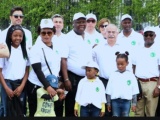he Great Rift Valley, which cleaves the earth from the Lower Zambezi River in Southern Zambia to the headwaters of the Nile in Egypt, is now known to be one of the cradles of the human race, and Zambia's present population lives on lands that have been inhabited by our forebears for uncountable aeons.
Archaeologists have established that in the northern African Rift Valley, the civilizing process got underway at least 3 million years ago, and crude stone implements, similar to some of that age found in Kenya, have also been found beside the Zambezi River.
Early stone age sites have been unearthed in many parts of Zambia, the most significant being at the Kalambo Falls in the North and at Victoria Falls in the south. At the former there is evidence that primitive humans began using fire systematically some 60,000 years ago. At the latter, a complex has been fully exposed showing the development of skills from the most distant past (this 'dig' is enclosed at the Field Museum at the Victoria Falls).
The skull of Broken Hill Man, dated to 70,000 years ago, gives an indication of what humans of that period looked like.
It was during the next phase – the middle Stone Age – with its refinement in the manufacture of tools, differentiation between populations, and burial of the dead, that modern man probably emerged in Zambia, at least 25 000 years ago.
We may imagine family groups of small-statured people living near water and sustaining themselves by hunting the abundant game as well as gathering fruits, tubers and honey from their surroundings (some skulls show serious tooth decay caused by honey?) They would often be on the move, following the antelope as they migrated with the seasons. By 15,000 years ago, the Late Stone Age commenced.
People began to live in caves and rock shelters, the walls of which they decorated with paintings. Very few of these have survived Zambia's seasonally humid climate, and those which have, do not display the sophistication found in the Rock Art found in Zimbabwe or South Africa. But a surviving drawing of an eland at Katolola in the Eastern Province suggests that this art was more than decorative, that it had a ritual or religious meaning: it has been shown in South Africa that this animal was sacred to the Late Stone Age people there.
This spiritual and artistic development occurred alongside another, the invention of the bow and arrow, which revolutionised hunting and also gave humans a mechanical weapon of war, a musical instrument, and a method of starting fire! It has been determined that the people of the Late Stone Age neither tilled the soil nor kept livestock.
New Arrivals
The Zambian Stone Age people probably resembled the present-day San, but towards the end of the period here, there is evidence, from skeletal remains of Negroid physical features, that the hegemony of the aboriginal population was coming to an end. During the centuries between 300 BC and AD 400 Zambia was gradually taken over by Negroid people, who by the later date had occupied the whole country. This was achieved slowly, which allowed the earlier way of life to persist into the present era. read more
The European Factor
The wealth of the Indian Ocean trade was one of the elements (another was to spread Christianity) that in the 15th Century inspired the Portuguese, who had recently reconquered their country from Muslim Moors, to embark on their bold 'Voyages of Discovery'. read more
Invasions from the South
Perhaps as a response to foreign intrusions in southern Africa, Shaka of the Zulu and Nguni clan, set about creating a centralized militaristic state in the early 19th century. Surrounding peoples who did not voluntarily agree to absorption into the growing Zulu empire had no option but to flee for survival. Three of these groups were to make a forceful impact on Zambia, 1500 km to the north of the Zulu heartland in eastern South Africa. read more
Missionaries and Colonisers
In 1840 David Livingstone, a 27 year old Scottish doctor and ordained minister, sailed from Britain to the Cape to work as a medical evangelist with the London Missionary Society. He was to open central Africa to the gaze of British imperialists. Meanwhile, Portugal was planning to consolidate its African territories by uniting Angola and Mozambique across the central plateau. read more
Empire
With considerable help from both Coillard and Dupont, the British imperialist Cecil John Rhodes' British South African Company (BSAC) had been able to take over the whole of Zambia by the end of the 19th century: that Frenchmen should have served the British Empire so well is one of the quirks of history! read more
King Copper
The discovery and opening up during the late 1920s and 1930s of the rich underground ore bodies along the Zambian Copperbelt were soon to make that small region – 120 km long by 40 km wide – one of the worlds' most concentrated and renowned mining areas. read more
Federation
The nationalist movement was given impetus in the early 1950s when the Colonial Office agreed to have Northern Rhodesia joined in a federation with Nyasaland (Malawi), a British 'protectorate', and Southern Rhodesia (Zimbabwe). Southern Rhodesia, under White settler rule, was bankrupt, and saw Northern Rhodesia, with its copper wealth as, to quote one of its political figures, a 'milch cow'.
The Federation was dissolved in 1963, its only enduring monument the Kariba Dam across the Zambezi, intended by the federalists to bind Northern and southern Rhodesia forever. In January the following year Zambia's first universal adult suffrage elections were held and though the ANC performed well in a few substantial areas, UNIP won convincingly, Kaunda becoming Prime Minister. Then at midnight on 24th October 1964, Zambia became an independent republic with him as president.
The one-party state was abolished and free elections were held in October 1991. Kaunda and UNIP were defeated eighty per cent to twenty per cent by the newly formed Movement for Multi-party Democracy, a broad coalition of different interest groups.









